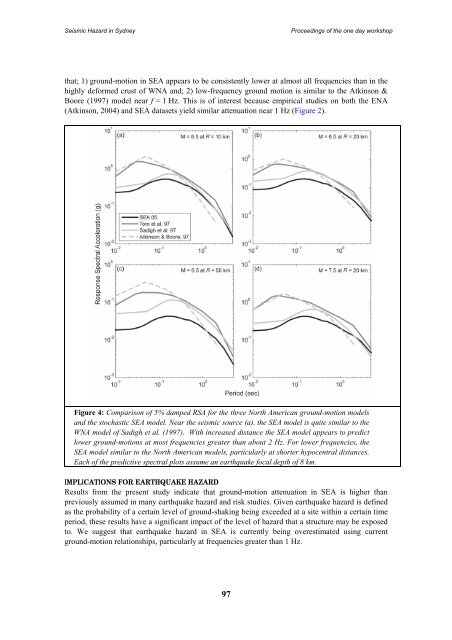Seismic Hazard <strong>in</strong> <strong>Sydney</strong>Proceed<strong>in</strong>gs of <strong>the</strong> one day workshopthat; 1) ground-motion <strong>in</strong> SEA appears to be consistently lower at almost all frequencies than <strong>in</strong> <strong>the</strong>highly deformed crust of WNA and; 2) low-frequency ground motion is similar to <strong>the</strong> Atk<strong>in</strong>son &Boore (1997) model near f = 1 Hz. This is of <strong>in</strong>terest because empirical studies on both <strong>the</strong> ENA(Atk<strong>in</strong>son, 2004) and SEA datasets yield similar attenuation near 1 Hz (Figure 2).Figure 4: Comparison of 5% damped RSA for <strong>the</strong> three North American ground-motion modelsand <strong>the</strong> stochastic SEA model. Near <strong>the</strong> seismic source (a), <strong>the</strong> SEA model is quite similar to <strong>the</strong>WNA model of Sadigh et al. (1997). With <strong>in</strong>creased distance <strong>the</strong> SEA model appears to predictlower ground-motions at most frequencies greater than about 2 Hz. For lower frequencies, <strong>the</strong>SEA model similar to <strong>the</strong> North American models, particularly at shorter hypocentral distances.Each of <strong>the</strong> predictive spectral plots assume an earthquake focal depth of 8 km.IMPLICATIONS FOR EARTHQUAKE HAZARDResults from <strong>the</strong> present study <strong>in</strong>dicate that ground-motion attenuation <strong>in</strong> SEA is higher thanpreviously assumed <strong>in</strong> many earthquake hazard and risk studies. Given earthquake hazard is def<strong>in</strong>edas <strong>the</strong> probability of a certa<strong>in</strong> level of ground-shak<strong>in</strong>g be<strong>in</strong>g exceeded at a site with<strong>in</strong> a certa<strong>in</strong> timeperiod, <strong>the</strong>se results have a significant impact of <strong>the</strong> level of hazard that a structure may be exposedto. We suggest that earthquake hazard <strong>in</strong> SEA is currently be<strong>in</strong>g overestimated us<strong>in</strong>g currentground-motion relationships, particularly at frequencies greater than 1 Hz.97
Seismic Hazard <strong>in</strong> <strong>Sydney</strong>Proceed<strong>in</strong>gs of <strong>the</strong> one day workshopAlthough we have not been able to develop a reliable stochastic ground-motion model for WA atpresent ow<strong>in</strong>g to <strong>the</strong> anomalous nature of <strong>the</strong> WA dataset, results from empirical studies suggest that<strong>the</strong> attenuation of strong ground-shak<strong>in</strong>g will be lower than <strong>in</strong> SEA. Consequently, we would expectto see larger ground-motions away from <strong>the</strong> fault rupture. Comparison of Fourier spectral models byAllen et al. (<strong>in</strong> press) <strong>in</strong>dicate that at lower-frequency ground-motions ( f < 2 Hz) attenuate less <strong>in</strong>WA than <strong>in</strong> ENA. In contrast, <strong>the</strong>y observe lower levels <strong>in</strong> high-frequency motions relative to lowfrequencymotions. It may be that <strong>the</strong> use of current attenuation models actually underestimateshazard at low-frequencies <strong>in</strong> WA. Therefore, low-frequency ground-motions may be slightly higherthan that of ENA models, but with dim<strong>in</strong>ished high-frequency motions. This is somewhat consistentto studies by Hao & Gaull (2004), who apply low-pass filters to ENA ground-motion models to fitobserved ground-motion from WA.CONCLUSIONSThis study presents <strong>the</strong> first ground-motion attenuation models that are appropriate for <strong>Australia</strong>ncrustal conditions. These empirical and stochastic models are based entirely on data recorded <strong>in</strong><strong>Australia</strong>. We have not dist<strong>in</strong>guished between attenuation models for Palaeozoic (e.g. Lachlan FoldBelt) and Mesozoic (e.g. <strong>Sydney</strong> and Gippsland Bas<strong>in</strong>s) crust, but ra<strong>the</strong>r have developed a comb<strong>in</strong>edground-motion model for <strong>the</strong> whole of sou<strong>the</strong>astern <strong>Australia</strong>. Develop<strong>in</strong>g models that describe <strong>the</strong>different geological terra<strong>in</strong>s <strong>in</strong> <strong>the</strong> region will be <strong>the</strong> scope of future work.Empirical attenuation models have been developed from two key datasets; one from WA and <strong>the</strong>o<strong>the</strong>r from SEA. In general we observe that ground-motion attenuates less <strong>in</strong> WA than <strong>in</strong> SEA,particularly at low frequencies. WA earthquakes, however, appear to have lower high-frequencymotion relative to SEA earthquakes.Given <strong>the</strong> difficulties associated <strong>in</strong> constra<strong>in</strong><strong>in</strong>g reliable source and attenuation parameters for <strong>the</strong>WA dataset, development of stochastic ground-motion models concentrate on SEA rock sites. Weobserve that near <strong>the</strong> earthquake source, SEA RSA <strong>in</strong>dicate similar spectral shape to <strong>the</strong> Sadigh etal. (1997) model developed for WNA with low levels of high-frequency motion (and PGA)compared to <strong>the</strong> two ENA models. As distance is <strong>in</strong>creased from <strong>the</strong> source, we observe that allpredictive attenuation models from North America overestimate ground-motion relative to <strong>the</strong> SEAmodel. These f<strong>in</strong>d<strong>in</strong>gs have significant implications for earthquake hazard and risk <strong>in</strong> this region.They suggest that by us<strong>in</strong>g North American ground-motion models, we are currently overestimat<strong>in</strong>gearthquake hazard <strong>in</strong> SEA. Consequently, we may be over-eng<strong>in</strong>eer<strong>in</strong>g <strong>in</strong>frastructure for strongground-motion, particularly for frequencies greater than 2 Hz. More work is required to quantify<strong>the</strong>se results, and also to develop useful models for both rock and soil sites. These models willprovide a means to lower <strong>the</strong> uncerta<strong>in</strong>ty associated with <strong>Australia</strong>n specific hazard and riskanalyses.ACKNOWLEDGEMENTSThe work detailed <strong>in</strong> this paper was done <strong>in</strong> collaboration, and with <strong>the</strong> f<strong>in</strong>ancial support of <strong>the</strong><strong>Australia</strong>n National Committee on Large Dams (ANCOLD). We particularly acknowledge <strong>the</strong>efforts of Phil J. Cumm<strong>in</strong>s of ANCOLD, coupled with Wayne Peck and Gary Gibson of ES&S toga<strong>in</strong> support from <strong>Australia</strong>n dam owners. We also thank Walt Silva and Nick Gregor of PacificEng<strong>in</strong>eer<strong>in</strong>g and Analysis for provid<strong>in</strong>g software and support for <strong>the</strong> development of <strong>the</strong> stochasticattenuation models.REFERENCESAllen, T.I., Dhu, T., Cumm<strong>in</strong>s, P.R. and Schneider, J.F. (<strong>in</strong> press). Empirical attenuation of groundmotionspectral amplitudes <strong>in</strong> southwestern Western <strong>Australia</strong>, Bull. Seism. Soc. Am.98
















